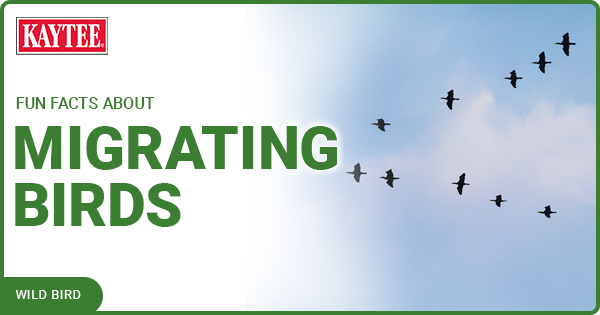20 Winter Birds You May See This Year
Winter ushers in dramatic changes for birds and opportunities for us to catch a glimpse of new species. This list of winter birds you may see this year is only a sampling, so get those binoculars ready!
20 Winter Birds You May See This Year
Southeast U.S.
Snow Goose: in winter flocks of tens of thousands of snow geese congregate in marshes, open fields, and shorelines of the northern Gulf and mid-Atlantic. They mate for life and goslings have been known to walk 50 miles on the arctic tundra (where they migrate at Winter's end) during the first three weeks of life following parents from nesting grounds to prime brooding areas.
Palm Warbler: a songbird seen on the ground in thickets and brushy fields. This bird is easy to identify by its constantly bobbing tail.
Forster's Tern: spends winter around sheltered waters near the coasts, as well as inland marshes. It is the only mid-sized tern on the U.S. mainland during winter.

Northeast U.S.
Evening Grosbeak: a yellow finch living in the woodlands. Watch for flocks at platform sunflower feeders during irregular winter migrations. With a small selection of sweet, simple notes, whistles and some chirps, this species is often thought of as a songbird that doesn't truly have a “song" for mating and defenses.
Purple Sandpiper: you can often see the Purple Sandpiper on rocky coasts of the Atlantic. A hardy species; they are the northernmost winter shorebird who simply hop in the air to avoid the pounding surf.
Golden-crowned Kinglet: this is a tiny songbird of living in mixed woods, preferably conifer trees. Its nostrils are uniquely covered by one tiny feather and it can survive temperatures below -40°F.
Midwest & Upper Plains U.S.
Snow Bunting: a species nicknamed “snowflakes" for the way these restless songbird flocks swirl and land in open fields. Males leave early for the Arctic breeding grounds where the temps can still be -20° F. They sing, fly and give a mate a tour of nesting sites.
Common Goldeneye: a duck found in variety of water habitats. They nest in tree cavities and provided boxes. Flock sections dive simultaneously to feed on aquatic invertebrates and fish.
Northern Goshawk: this is the largest accipiter of the forests. The Northern Goshawk is fierce, powerful, and secretive with swift and accurate flying abilities.
Central & Southern Plains U.S.
Sandhill Crane: huge flocks descend on marshes, bogs, and prairies. They are the oldest known bird species living to 36 years. The Sandhill Crane has an elegant crane dance during courtship and can be heard miles away during overhead migration.
Dark-eyed Junco: a “snowbird” found in mixed woodlands, edges, and backyards. Large flocks appear as a signal of snow. With as many as 16 different subspecies, classification debates are still ongoing for this family of birds.
American Bittern: this is a heron living in shallow wetlands with tall vegetation. They are experts at camouflage, patient statue-like poses with head pointed upward making them a challenge to locate.
Southwest & Southern Rockies U.S.
Northern Harrier: prefers open landscapes with ground vegetation. The most prominent way to distinguish a Northern Harrier is their owl-shaped face (no relation) to funnel sound to their sharp auditory skills - rare amongst hawks who mainly rely on keen eyesight.
Cedar Waxwing: found at edges of woods, streams, fields, swamps, and suburbia. You’ll find them in backyards in flocks. They’re one of the few North American species that are fruit specialists. It’s common for females to fly over 2,500 while collecting supplies for nest building.
Red-naped Sapsucker: this species is the woodpecker found in mountains and lowlands in deciduous forests. They’re omnivores that enjoy sap from neatly spaced horizontal holes in trees, insects and fruits.
Northwest & Northern Rockies U.S.
Mew Gull: migrating flocks found in and around watery habitats along Pacific coast south to Mexico. A delicate shorebird with a sweet expression, and the only white-headed gull that may nest in trees.
American Tree Sparrow: selects brushy, weedy areas and backyards during migration. Despite the name, American Tree Sparrows are a ground forager with a sweet, musical song.
Lapland Longspur: a fallow field songbird that migrate in large flocks and the only longspur that travels outside North America. They eat a combination of 3,000 to 10,000 insects and seeds per day.
Alaska
Bald Eagle: the Bald Eagle is a year-round resident along the coasts and Aleutian Islands. They’re able to fly hundreds of miles per day; an opportunistic hunter and have been seen playing together with sticks and other objects.
Hawaii
Pacific Golden Plover: a shorebird found at mudflats, shorelines, and backyards. Fossil records found this Arctic migrant dating back 120,000 years. Local culture calls this bird, “kolea”, for leading early Polynesians to the islands.
Many of these species mentioned occur across multiple regions in the U.S. Consult your favorite guide for specifics. This list is to inspire a closer look in your backyard, neighborhood, and wildlife areas.
Happy Birding!
~
Sources:
National Audubon Society
The Cornell Lab of Ornithology
Sibley, David Allen, The Sibley Guide to Birds.









.png?h=315&iar=0&w=600&hash=9C09A701CB4D5CF9B2C5B7FA2DA01F2E)



